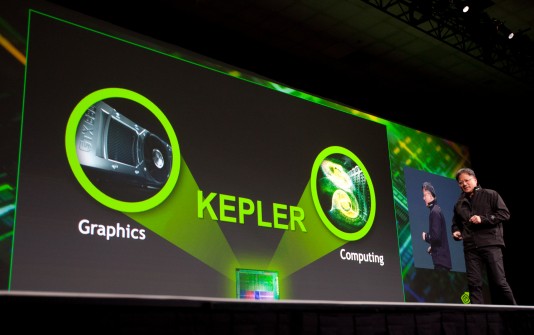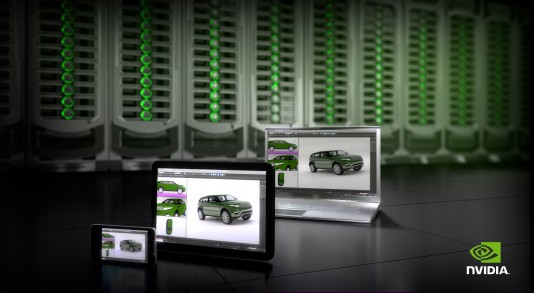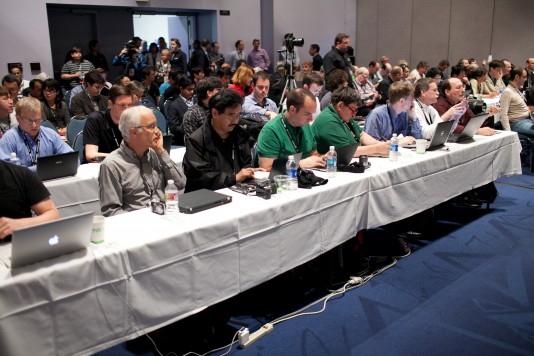Nvidia says previously unobtainable performance opens the door to a variety of possibilities including streaming games like movies or doing sophisticated simulations from the cloud. Power efficiency gains are as important as the graphics gains.
Nvidia today unveiled Kepler, a new generation of graphics technology, promising previously impossible commercial graphics performance coupled with previously unrealized energy efficiency. The new technologies will be delivered in two ways: in a new generation of Tesla-brand graphics processor units (GPUs) for desktop computing and as a cloud-based technology.

Nvidia’s graphics technology seems to spawn its own language. Before diving into the specifics of today’s news, here’s a glossary of terms:
- Quadro: Nvidia’s brand name for PC and mobile graphics cards;
- Tesla: The brand name for Nvidia’s graphics processing units, which offer parallel computation to accelerate graphics performance;
- Fermi: The name given to the current generation of Nvidia GPU architecture delivered on Tesla boards;
- Kepler: The next generation of Nvidia’s GPU technology, announced today;
- VGX: A virtual version of Kepler technology, for delivering GPU technology as a cloud-based service.
In general, Nvidia says its Kepler generation of GPU technology is three times more efficient than the previous generation Fermi architecture. When Fermi was introduced two years ago it set the standard for parallel computing for graphics and became popular in high-performance computing (HPC). Kepler technology will be delivered to workstations in two products, the Tesla K10 and K20. The Tesla K10 will be available within 30 days, for a price yet to be established; the K20 will be available in the fourth quarter of 2012.
A video, posted to YouTube by TheVerge.com, demonstrating Kepler technology for real-time ray tracing at the GTC opening keynote.
Both new Tesla devices will benefit from SMX, Nvidia’s upgrade to SM, streaming multiprocessor technology introduced with Fermi. In the Fermi generation, streaming multiprocessing used 32 cores; Kepler’s SMX it uses 192 cores, and at the same time is more energy efficient. Nvidia claims energy efficiency of three times more performance per watt. Energy use has become a major issue in high-performance computing, making energy efficiency a crucial deployment criteria.
The K10 will be a nice upgrade from the current Fermi architecture, but Nvidia is pulling out the stops with the K20. It offers two new technologies that hold great potential for transforming commercial computing. The first, Dynamic Parallelism, allows existing GPU threads to dynamically spawn new threads. In effect, the GPU adapts dynamically to data as it is processed. Nvidia says this greatly simplifies parallel programming, enabling GPU acceleration of a broader set of popular algorithms, such as adaptive mesh refinement, fast multi-pole and multi-grid methods. More computation can be accomplished without having to report back to the CPU for another instruction.
The second new technology is Hyper-Q, which enables multiple CPU cores to simultaneously use the CUDA architecture cores on a single Kepler GPU. If GPU computing is a buffet, Fermi offered diners one line, while Kepler now offers 32 lines.
The Tesla K10 sports two Kepler GPUs that deliver an aggregate performance of 4.58 teraflops peak single-precision floating point and 320 GB per second memory bandwidth. The K20 will offer three times more double precision processing compared to Fermi architecture-based Tesla products. The Oak Ridge National Laboratory will be one of the first customers for Kepler technology, installing the GK110 GPU chip (used in both the K10 and K20) into the new Titan supercomputer being built at the Oak Ridge National Laboratory in Tennessee and the Blue Waters system at the National Center for Supercomputing Applications at the University of Illinois at Urbana-Champaign.

GPU to the cloud
In addition to releasing next-generation general-purpose graphics processing technology on new graphics boards for workstations and servers, Nvidia is releasing a cloud version of the technology, called the Nvidia VGX platform. Cloud service providers and IT departments will be able to use VGX to deliver a virtualized desktop with the graphics and GPU computing performance of a PC or workstation to employees using any connected device. In a demonstration at the GPU Technology Conference (GTC) in San Jose, California today, Nvidia CEO Jen-Hsun Huang showed an iPad running a Windows desktop, with access to such programs as Autodesk’s Maya and Showcase.
The net effect of VGX is to allow an enterprise to deliver any application to the screen of anyone using virtualization technology. Huang referred several times to the BYOD revolution sweeping the business world, with BYOD standing for “bring your own device.” He compared it to the days when key employees would be issued a company car. The current generation, he said, already has their computing devices; now it is up to the IT departments to support them.
Today’s knowledge workers can access enterprise business applications in a virtual environment, but not key creative applications such as CAD or digital content creation. Nvidia says VGX brings a GPU-accelerated desktop to the virtual environment, and offers latency low enough to work with demanding 3D design and simulation tools, which had previously been too intensive for a virtualized desktop.
Today if an IT department wants to virtualize access to GPU technology, it has to do so on a one-to-one basis of one remote user linked to an assigned GPU. VGX frees up GPU technology to be accessed by the network of users. Nvidia is working hand-in-hand with virtualization leader Citrix and networking leader Cisco in bringing this technology to market.
Nvidia VGX is based on three key technologies:
NVIDIA VGX boards designed for hosting large numbers of users in an energy-efficient way. The first VGX board is configured with four GPUs and 16 GB of memory, and fits into the industry-standard PCI Express interface in servers;
NVIDIA VGX GPU Hypervisor, a software layer that integrates into commercial hypervisors, such as the Citrix XenServer, enabling virtualization of the GPU;
NVIDIA User Selectable Machines (USMs), a manageability option that allows enterprises to configure the graphics capabilities delivered to individual users in the network, based on their demands.
The Nvidia VGX platform enables up to 100 users to be served from a single server powered by one VGX board. Nvidia says VGX will sharply reduce such issues as latency, sluggish interaction, and limited application support.

Big expectations
Nvidia’s announcements today set a table of big expectations in several dimensions. Any of the key new technologies are in and of themselves a big deal. Delivering 3x energy efficiency answers a key concern among HPC and supercomputing users, who have been worrying about the rising costs—economic and social—that come with advanced computing. A virtualization of GPU technology gives the enterprise new cost-effective incentive to empower employees who want their tablet cake and eat it too. The redefinition of parallel processing delivered in Kepler will likely spawn another revolution in scientific advancement, just as the two previous generations of Nvidia’s general-purpose graphics processing have already done.
A variety of technical and economic issues have to be re-evaluated in the light of Kepler technology. In CAD and DCC, Kepler technology makes possible real-time ray tracing of complicated live scenes such as breaking glass, or moving shadows and reflections. In gaming, VGX opens the door to delivering games as a streaming service, the way Netflix delivers movies.





